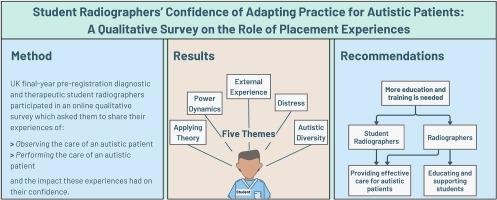Student radiographers’ confidence of adapting practice for autistic patients: A qualitative survey on the role of placement experiences
IF 2.5
Q2 RADIOLOGY, NUCLEAR MEDICINE & MEDICAL IMAGING
引用次数: 0
Abstract
Introduction
Healthcare services can be inaccessible to autistic people without adaptions to clinical practice and the care provided. Therefore, understanding how radiographer education develops students' confidence in adapting care for autistic patients is crucial. This study aimed to explore how placement experience impacts student radiographer confidence in adapting care for autistic patients.
Methods
UK final-year student diagnostic and therapeutic radiographers were invited to complete a qualitative online survey. The survey asked for a description of placement experiences; of observing and/or performing the care of autistic patients and how this impacted confidence in caring for autistic patients. The data was thematically analysed.
Results
43 responses (of 44 received) were included, from which 5 themes emerged. Those who felt placement experiences developed confidence described opportunities to apply theory learnt at university (theme 1) or drew attention to the benefit of prior (external) experience with autistic people (theme 3). However, the balance of power with the supervising radiographer (theme 2), witnessing autistic patients in distress (theme 4), and the heterogeneous nature of autism (theme 5) disrupted students’ development of confidence.
Conclusion
Several participants in this study found clinical placement developed confidence with autistic patients through applying knowledge and providing an opportunity for reflexive learning. However, various obstacles hindered this development, such as witnessing distressed patients, limited experiences with autistic patients and difficulty navigating relationships with radiographers.
Implications for practice
To improve student radiographers’ confidence of providing care for autistic patients, educators should consider methods, e.g., co-produced simulation, to fill potential gaps in their experience. There is also a pressing need for all radiographers to understand their responsibility in educating students and their impact on student wellbeing.

学生放射技师为自闭症患者调整实践的信心:关于实习经历作用的定性调查。
导言:如果不对临床实践和所提供的护理进行调整,自闭症患者可能无法获得医疗保健服务。因此,了解放射技师教育如何培养学生适应自闭症患者护理的信心至关重要。本研究旨在探讨实习经验如何影响放射技师学生为自闭症患者调整护理的信心:方法:邀请英国诊断和治疗放射技师专业的毕业班学生完成一项定性在线调查。调查要求描述实习经历、观察和/或护理自闭症患者的经历,以及这些经历如何影响护理自闭症患者的信心。我们对这些数据进行了专题分析:在收到的 44 份答复中,有 43 份被采纳,并从中产生了 5 个主题。那些认为实习经历增强了自信心的人描述了应用大学所学理论的机会(主题 1),或提请注意先前(外部)与自闭症患者接触的经验所带来的益处(主题 3)。然而,与指导放射技师之间的权力平衡(主题 2)、目睹自闭症患者的痛苦(主题 4)以及自闭症的异质性(主题 5)破坏了学生自信心的发展:本研究的几位参与者发现,临床实习通过应用知识和提供反思性学习的机会,培养了学生对自闭症患者的信心。然而,各种障碍阻碍了这一发展,例如目睹痛苦的患者、与自闭症患者接触的经验有限以及难以处理与放射技师的关系:为提高学生放射技师为自闭症患者提供护理的信心,教育者应考虑采用共同制作模拟等方法来弥补他们在经验方面的潜在不足。此外,所有放射技师都迫切需要了解他们在教育学生方面的责任以及他们对学生福祉的影响。
本文章由计算机程序翻译,如有差异,请以英文原文为准。
求助全文
约1分钟内获得全文
求助全文
来源期刊

Radiography
RADIOLOGY, NUCLEAR MEDICINE & MEDICAL IMAGING-
CiteScore
4.70
自引率
34.60%
发文量
169
审稿时长
63 days
期刊介绍:
Radiography is an International, English language, peer-reviewed journal of diagnostic imaging and radiation therapy. Radiography is the official professional journal of the College of Radiographers and is published quarterly. Radiography aims to publish the highest quality material, both clinical and scientific, on all aspects of diagnostic imaging and radiation therapy and oncology.
 求助内容:
求助内容: 应助结果提醒方式:
应助结果提醒方式:


